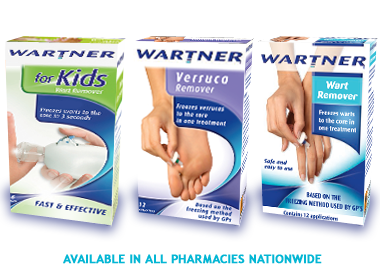What different wart and verruca treatments
are available?
Professional treatments

If you are not sure whether a skin condition is a wart or a verruca, or if home treatments applied as directed have not worked, we recommend that you see your doctor.
Cryotherapy: Cryosurgery or freezing usually involves liquid nitrogen, which has a temperature of -196° C. One misconception that many people have is that they think the wart or verruca is immediately frozen or burnt off. This isn’t true, freezing slowly breaks down the skin and a blister forms around the problem area. The dead tissue falls off within 10-14 days.
The freezing may cause a little discomfort, but it is one of the most effective treatments there is. It doesn't leave a scar and there's no danger of spreading the HPV virus. In fact, it also has an added effect of stunning the virus. Cryotherapy has therefore become the standard medical treatment for the removal of warts and verrucas. Larger warts and verrucas may need several treatments, with a three to four week interval in between.
Surgery: Surgical excision of warts and verrucas has a high success rate. There is some discomfort with this procedure and it takes several weeks for the area to heal completely. The risks associated with surgical removal are the possibility of infection and scarring.
Burning or electrocautery: Electrocautery consists of a small probe with an electric current running through it, which is used to destroy the tissue. Burning is often effective, but can leave scars.
Laser: Laser surgery uses an intense beam of light to burn and destroy the tissue of the wart or verruca. Local or general anaesthetic may be used. Laser surgery may be considered when the problem is large or widespread. Laser surgery doesn't normally cause any scarring. The wound will be painful for a few days afterwards and there is a slight risk of infection associated with laser surgery.
Non-prescription remedies

Salicylic acid: There is a wide variety of creams, gels, lotions and medicated plasters available. Most of these contain salicylic acid as their active ingredient. Salicylic acid works by destroying the thickened skin, which makes up the wart or verruca. This can then be rubbed off with an emery board or pumice stone. Other chemicals, including formaldehyde and glutaraldehyde, work in a similar way. However, chemicals may also destroy healthy skin, so it's important to protect the surrounding area. To get good results, you must apply the acid every day and rub dead skin off once a week with a file or pumice stone. This treatment can take many weeks, even months.
Cryotherapy: The increasingly popular freezing method, successfully used by doctors, is now available for use at home with Wartner. Wartner uses dimethyl ether which is clinically proven to be as successful as liquid nitrogen.
Others: Less frequently used non-prescription remedies are Duct tape which covers and irritates the wart and the skin around it, causing the body to attack it, or Silver nitrate pencil, a treatment which also burns away warts.


